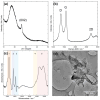Mechanical and Antimicrobial Properties of the Graphene-Polyamide 6 Composite
- PMID: 39063756
- PMCID: PMC11278109
- DOI: 10.3390/ma17143465
Mechanical and Antimicrobial Properties of the Graphene-Polyamide 6 Composite
Abstract
This paper presents the synthesis and characterization of graphene-polymer composites, focusing on their mechanical and antibacterial properties. Graphene flakes were obtained via an electrochemical method and integrated into polyamide 6 (PA6) matrices using melt intercalation. Various characterization techniques confirmed the quality of the graphene flakes, including X-ray diffraction (XRD), Raman spectroscopy, and infrared (IR) spectroscopy, as well as scanning and transmission electron microscopy (SEM and TEM) imaging. Mechanical tests showed an increase in the elastic modulus with graphene incorporation, while the impact strength decreased. The SEM analysis highlighted the dispersion of the graphene flakes within the composites and their impact on fracture behavior. Antimicrobial tests demonstrated significant antibacterial properties of the composites, attributed to both oxidative stress and mechanical damage induced by the graphene flakes. The results suggest promising applications for graphene-polymer composites in advanced antimicrobial materials.
Keywords: PA6; antimicrobial activity; composite; graphene flakes; mechanical properties; polyamide.
Conflict of interest statement
The authors declare no conflict of interest.
Figures






References
-
- Wen Y., Liu H., Jiang X. Preparation of Graphene by Exfoliation and Its Application in Lithium-Ion Batteries. J. Alloys Compd. 2023;961:170885. doi: 10.1016/j.jallcom.2023.170885. - DOI
-
- Zhou A., Yu T., Liang X., Yin S. H2O2-Free Strategy Derived from Hummers Method for Preparing Graphene Oxide with High Oxidation Degree. FlatChem. 2023;38:100487. doi: 10.1016/j.flatc.2023.100487. - DOI
-
- Bahri M., Gebre S.H., Elaguech M.A., Dajan F.T., Sendeku M.G., Tlili C., Wang D. Recent Advances in Chemical Vapour Deposition Techniques for Graphene-Based Nanoarchitectures: From Synthesis to Contemporary Applications. Coord. Chem. Rev. 2023;475:214910. doi: 10.1016/j.ccr.2022.214910. - DOI
-
- Sellathurai A.J., Mypati S., Kontopoulou M., Barz D.P.J. High Yields of Graphene Nanoplatelets by Liquid Phase Exfoliation Using Graphene Oxide as a Stabilizer. Chem. Eng. J. 2023;451:138365. doi: 10.1016/j.cej.2022.138365. - DOI
Grants and funding
LinkOut - more resources
Full Text Sources

